Android isn't as big as you think
Yes, Google's mobile operating system is huge. The latest numbers from ABI Research have the operating system accounting for 78% of all smartphones shipped worldwide in 2013. But the numbers also show Android has a slightly weaker grip on the smartphone world than we may think it does.
Android's true influence
In its report released at the end of January, ABI Research showed that although Google's OS dominated the mobile market in Q4 2013, the share of Google-controlled Androids are waning in light of "forked" versions. So-called forked versions don't come preinstalled with Google's suite of apps or direct access to the Google Play Store, though they can run regular Android apps. And they're growing fast.
Here's a look at how the forked versions, also referred to as Android Open Source Project (AOSP)-based phones, stack up against non-forked versions:
When separated out from certified Android versions, we see AOSP-based phones nab 25% of all smartphone OSes in the last quarter of 2013, up from 14% a year earlier. That's more than BlackBerry and Apple's operating systems. But most importantly, it's causing the market share of official Android versions to shrink.
Why this matters
Most of AOSP's growth comes from the Indian and Chinese mobile markets, where the populations are buying up smartphones faster than other markets.
The implications for Google are notable but not devastating -- at least for now. The company has made moves to further set its official versions of Android apart from the open source kind. In an investor note, Jefferies & Co.'s analyst Hyunwoo Doh, recently wrote:
Google's main strategy is to reduce Android's compatibility with AOSP, by: 1) increasing the number of GMS applications; 2) gradually changing the runtime system from Dalvik to Android RunTime (ART); and 3) increasing the number of coding native applications with C/C++, using Native Developer's Kit (NDK) and Java Native Interface (JNI).
That's a bit technical, but it essentially means Google is trying to make it more difficult for AOSP to gain additional market share by increasing the standards phone makers need to have in order to make their versions of Android compatible with Android apps and services. But reining in the forked versions won't be easy.
Even Nokia, a long supporter of the Windows Phone platform and future Microsoft company, introduced an AOSP-powered device late last month. The Nokia X is targeted at India and China and could raise the forked versions of Android even higher. Preorders for the device were at 10 million in China within the first week.
The recent and somewhat surprising success of the Nokia X paints a growing and slightly gloomy picture for Google. Xiaomi, one of the fastest growing smartphone brands in China, uses forked versions of Android as well. The company sticks relatively close to the Android OS, so its phones can be updated and run the latest apps, but that doesn't help Google make money from its app store. Xiaomi's ambitions go far beyond China, something that could add to AOSP's growth.
If Google's intention was to release a free OS so it could make money with long-tail purchases through its services and app store, AOSP is inhibiting that ambition.
Foolish final thoughts
Though Google is trying to persuade original equipment manufacturers to release full versions of Android running Google's app store, it's clear the company hasn't fully succeeded. That could be advantageous for Apple and Microsoft. The two companies obviously want more share of the mobile space, and if Android essentially steals market share away from itself, than even better.
Apple meanwhile is pushing harder into China, and the possible launch of a new, and bigger, iPhone this year could help its efforts even more. Google could likely wrangle in AOSP whenever it wants and force OEMs to use Android as Google truly wants it be used. But at this stage of the game, the company seems happy to perform the balancing act of tightening its control of Android, while leaving much of it open at the same time. That is, until the latter starts significantly cannibalizing app store revenue.
Are you ready for this $14.4 trillion revolution?
Let's face it, every investor wants to get in on revolutionary ideas before they hit it big. Like buying PC-maker Dell in the late 1980s, before the consumer computing boom. Or purchasing stock in e-commerce pioneer Amazon.com in the late 1990s, when it was nothing more than an upstart online bookstore. The problem is, most investors don't understand the key to investing in hyper-growth markets. The real trick is to find a small-cap "pure-play" and then watch as it grows in EXPLOSIVE lockstep with its industry.
Article Source: Android isn't as big as you think





/image%2F0495025%2F20140910%2Fob_0745d3_ob-ce9070-iwatch.png)
/https%3A%2F%2Fassets.over-blog.com%2Ft%2Fcedistic%2Fcamera.png)
/image%2F0495025%2F20140409%2Fob_8a45b8_9ebf8681421183cef25edb1789147c02)
/image%2F0495025%2F20140402%2Fob_b754cd_bgr-htc-one-m8-8.jpg)
